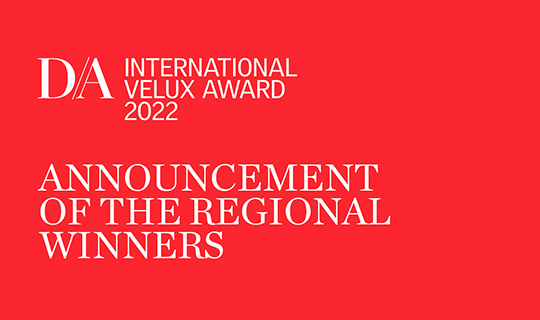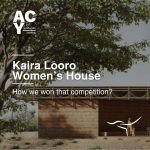The International VELUX Award 2022 announces ten regional winners
The International VELUX Award jury selected ten regional winners from the 507 submitted projects, from 211 school of architecture around the world.
The renowned jury comprised of Anupama Kundoo, Anupama Kundoo architects (IN), John Ronan, John Ronan Architects (US), Rainer Hofmann, Bogevischs Buero (DE), Fuensanta Nieto, Nieto Sobejano Arquitos (ES), and Lotte Kragelund from VELUX A/S (DK) who met for the jury meeting in Copenhagen.
It is great to see such a fantastic response to the competition, from so many schools of architecture around the world. Our aim with this competition is to bring together teachers and students on the topic of daylight. It is rewarding to see so many beautiful, innovative and responsible approaches to the theme ‘Light of tomorrow’ – stated Tina Christensen, the director of the International VELUX Award.
The jury noted that the future-oriented nature of the projects was high in imagination and aspiration. It was the overall impression that the students are engaged in the environmental, social, cultural and political key issues of our time and that they are really seeking and exploring solutions. In particular, the jury were struck by the range of issues that the students identified as being relevant to their future. This consisted of both common global themes as well as regional and local concerns. The jury were particularly drawn to projects that make a specific impact on the environment and show the potential for an architectural intervention of equality.
Natural light is a resource that will become ever more pertinent given the growing high-density nature of the urban fabric. There is thus a genuine daylight challenge for all of us and a need for greater knowledge and willingness to work with daylight in architectural practice, which the student projects demonstrate.
The jury made their final evaluation of the projects in accordance with the following criteria from the award brief: 1) the work with daylight as a premise for architecture, 2) how the project is researched and documented, 3) how the project addresses contemporary and future challenges, 4) the level of experimentation and innovation, as well as the overall graphic presentation of the project or how the project presents itself.
The jury unanimously selected the winners as listed below.
The following regional winning projects in the Daylight in Buildings category were awarded with 1,000 € for the student(s) and 250 € for the teacher(s).
Region Africa, project: Aqua Mart

Student: Elmarie van Staden
School: Greenside Design Centre, College of Design
Teacher: Jean Wiid
Country: South Africa
Improving the health of people in townships by sterilizing the water while simultaneously offer shelter from the sun with the help of a street mart. The idea is to place clear recycled bottles on the framework for sterilization by sunlight while giving shade with unique light patterns to help relax in the shade.
Water can be sterilized from harmful bacteria by using UV-A rays from the sun by placing it in the sun for 6hr. The recommended bottle to use is a PET bottle, and should be no bigger than a 2 liter bottle. Why Mfuleni, Inqilo St.: The space is near a taxi stop and at the entrance of the township. Therefore the space can be used as a market, resting place and water purifying area. Clean water is a very serious problem they are currently facing.
Region The Americas, project: 24-HOUR DAYLIGHT: A pavilion that reconnects the city with light

Students: Adrian Paocarima Herrera, Melissa Anabelle Ulcuango Merino and Kevin Daniel Arroyo Males
School: Universidad central del Ecuador
Teacher: Paul Esteban Paredes Escobar
Country: Ecuador
The symbolic value of the building takes advantage of its formal configuration to connect with the pre-Colonial Chakana, the arches and proportions of the colonial architecture of the church, and the need for contemporary technological construction. Therefore, for those who visit it, you can feel in this ephemeral timeless emptiness that allows them to guide their assessment of natural light towards healthier cities and where natural and artificial light are not opposites, but rather one that is reinterpreted as the hours go by. If current generations break the paradigm of dichotomy between natural and artificial light, we can have cities with a single light that is reinterpreted over time.
Region Asia & Oceania, project: Lighting up, Neighbourhood Hop

Students: Feng Meiyin, Feng Yijun and Zhang Jinru
School: Beijing Jiaotong University
Teacher: Wang Xin
Country: China
Nowadays, along with the rapid process of urbanization, social structure changes bring pressure to urban public security, and the crime rate is also rising. This phenomenon occurs in both developed and developing countries in the initial period of industrialization and urbanization. For example, in 1920, the ratio of urban and rural population in Japan was 37:63, while the ratio of urban crime to rural crime was 56:44; Before World War II, French cities accounted for only 30 percent of the national population, but urban crimes accounted for 46 percent of all crimes; And in the last 15 years in America, the incidence of criminal activity in big cities has been more than twice higher than in other communities on average.
Region Eastern Europe & the Middle East: TIP – Time Indicate Protection

Student: Zuzanna Sazonow and Aleksandra Pytka
School: Politechnika Poznańska
Teachers: Patrycja Kamińska
Country: Poland
The project of the modular shading system is a proposal for the adaptation of multi-family residential buildings to changes, which have appeared over the years and significantly affect the quality of use of apartments in old buildings. The main factors are climate change and changes in a way of functioning of the society that has succumbed over the past years. Among the most dangerous phenomena for the City of Poznań related to climate change are more frequent and longer heat waves. According climate models taking into account greenhouse gas emission scenarios, developed on the basis of meteorological data from the period 1981-2015, in the perspective of 2050, these phenomena will deepen. By the year 2050, the maximum temperature in the summer period, the number of hot days and the number of periods of at least 5 days with temperature exceeding 5 ° C will increase. Our project is the anwser to constantly changing climate conditions and new post-pandemic lifestyle that the society is dealing with right now. Nearly 25% of Poles maintain to work from home. It is necessary to help adapt homes that used to be only “bedrooms” for spending more time inside because of e.g. homeoffice. Our project is designed to prevent homes from overheating during the day while at the same time not blocking completly the view form the window.
Region Western Europe: Spotlight Tree: Self-regulating System in Desert Environment

Students: Zhao Liuxin, Liu Wanchen, Xin Guanbai and Dong Zhenbin
School: The University of Sheffield
Teacher: Bobby Nisha
Country: United Kingdom
The idea of the design came from the tree and nyctinastic movement of plants. Nyctinastic movement makes leaves open during the day and close at night. Then we can use the device modify this law of nature, making leaves open as sunshades when the light is strong, and close to allow the light in when it is weak.
The following regional winning projects in the Daylight Investigations category were awarded with 1,000 € for the student(s) and 250 € for the teacher(s).
Region Africa: Limitless Daylighting

Students: ISHIMWE MUNYANDEKWE Augustin
School: University of Rwanda – School of Architecture & Built Environment
Teacher: Dr Josephine Malonza
Country: Rwanda
The project aims at improving daylight in unplanned settlements where normal daylighting solutions seem to be inefficient. The possible solution in these kind of settlements is opening skylight to let light in. Opening a skylight come with a Heat and Glare problems which are the common problems in tropical buildings. The concept is developed to overcome Glare by preventing direct sunlight from the created skylight where light is put through sequences of refraction and reflections to make its presence in a mild and agreeable intensity. By providing an escape for hot air and an entry for cool air, the problem of heat is solved. The possibility to store sunlight energy in form of chemical energy made it possible to remove the limits of using sunlight imposed by the falling of night where these chemicals “Azobenzene” release heat in presence of a catalyst.
Region The Americas: Martian Light

Students: Gray Burke
School: University of Miami
Teacher: Yasmine Zeghar Hammoudi
Country: United States of America
The year is 2120, the Earth has been run dry of its resources and the only solution to survival is life on Mars. But how will we adapt to the lighting conditions of the harsh Martian glare….? Is the future of VELUX products in the prospects of space?
Region Asia & Oceania: Under the Three Gorges Project

Students: Yawen Qiao, Deng Teng, Haoyu Zhang, Shuyang Yan
School: Southwest Jiaotong University
Teacher: Jun Wang and Huang Xuan
Country: China
During the Zhong Yuan Festival, the migrants are allowed to rekindle their underwater homeland by releasing river lanterns. Of course, this is all done in an environmental-friendly way. During the lighting period, re-communicating with the past neighbors, it is as if one has never moved. The flickering of the river lanterns in the water is the thoughts and words of the Three Gorges migrants for their homeland, while it is also like a scene from a dream as if one has returned to his ancestral home. This is both a ritual and a memorial, as well as a reconnection of the Three Gorges immigrants with their broken ancestral home and local feelings.
Region Eastern Europe & the Middle East: Flight

Students: Sajjad Navidi, Mahya Mousavi Sadr and Elham Bahadori
School: University of Art, Tehran
Teacher: Rima Fayaz and Maryam Fakhari
Country: Islamic Republic of Iran
War is the most horrible crisis in the world. Displacement is part and parcel of war and significant humanitarian challenges of our time. Driven from their homes, these refugees—more than half of whom are children—have been deprived of their statehood, material possessions, and in many cases, their loved ones. They seek solace in purpose-built refugee camps and unplanned settlements, where they wait for their displacement or attempt to begin a new life. Refugee camps’ problems, such as congestion, poverty, lack of hygiene and drinking water, lack of safety and lack of light causes thousands of physical and mental difficulty for families, especially for children. The absence or lack of light after sunset can have a devastating effect on safety and security. Without light, simple activities such as visiting the toilet, collecting water, returning to the shelter from elsewhere, gatherings with family and friends, or completing homework after dark can become difficult and dangerous for children, particularly for girls. And Darkness intensifies the feeling of insecurity. As most refugee camps are located in lands with high solar absorption potential, this infinite possibility can be used to mitigate the crisis. Photovoltaic cells can be used to absorb and store daylight and use it at night. Children are the light of tomorrow and due to the more critical situation for children, this project aims to provide light for this group. So it should have features such as lightness and portability, combined with the tools they use every day, such as toys and creating a sense of belonging.
Western Europe: Solar Hymnal

Students: Jaan Gröndahl
School: Metropolia University of Applied Sciences Teacher: Janne Järvinen
Country: Finland
Retired gasholders speckle the post-industrial landscapes of Europe. Solar Hymnal proposes to transform these unique structures into future memorials; to our collective fossil fuel past, a visceral reminder of society’s ability to undergo difficult transformations. Under changing sun conditions, the installation begins to create an ever shifting chordal tone, as the white curtains form a beacon like collage of reflected light, shadow and diffuse glow.
The regional winners are invited to the 3-day trip to Lisbon, Portugal, to the World Architecture Festival end of November. At this largest global annual architectural event, they will present their projects to the jury.
In essence, what we were looking for was projects that foreground daylight and directly address the theme, Light of tomorrow. There had to be a vision, but also there had to be technical support of that vision and concise explanation of the idea. The selected regional winners were good on all three of those areas. And I can speak for the whole jury when I say that we’re all very excited to see the students present their work in Lisbon, the verbal communication of their idea – says John Ronan, the jury chair.
After the regional winners’ project presentation at the World Architecture Festival, the jury will select the two global winners of the International VELUX Award 2022. The winners in categories Daylight Investigations and Daylight in Buildings will receive the prize of 5,000 €; 4,000 € to the student(s) and 1,000 € to the teacher(s).
About the International VELUX Award
The International VELUX Award is a competition for students of architecture that runs every second year. Since the launch in 2004, it has grown into the largest competition of its kind with students from 800 schools, from 130 countries of all continents, submitting more than 6,000 projects on the award theme “Light of Tomorrow”.
International VELUX Award 2022 is organised in close collaboration with the International Union of Architects and the World Architecture Festival, and is acknowledged by the European Association for Architectural Education.
Congratulations to all of the winners!








